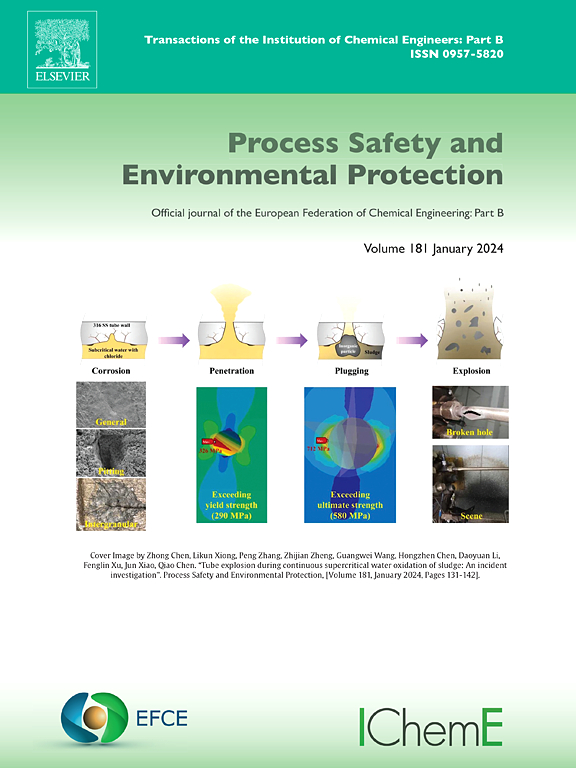新型自凝跨临界CO2动力循环喷射式制冷的热经济分析与优化
IF 6.9
2区 环境科学与生态学
Q1 ENGINEERING, CHEMICAL
引用次数: 0
摘要
跨临界CO2动力循环是利用废热和可再生能源的一种很有前途的方法,但其实际应用受到工作流体冷凝挑战的限制。为了解决这一问题,提出了一种新型的自冷凝跨临界CO2动力循环(SC-TCO2PC),它将跨临界CO2动力循环与喷射器制冷循环相结合。建立了详细的数学模型,并从热力学和经济学的角度对关键参数与系统性能之间的关系进行了参数化研究。然后应用多目标优化来探索性能提升的潜力。在优化条件下,对SC-TCO2PC与调蓄式超临界CO2布雷顿循环(SCO2BC)进行了对比分析。结果表明,涡轮进口压力和温度的提高对SC-TCO2PC的热经济性能有积极的影响。此外,SC-TCO2PC的最高热效率为43.90 %,火用效率为72.97 %,每单位电力的最低成本为0.0372美元/千瓦时,与可回收的SCO2BC相比,最高热效率提高了4.88 %,最高火用效率提高了6.60 %,最低单位电力成本降低了8.87 %。在最佳条件下,SC-TCO2PC能够实现42.11 %的热效率和70.54 %的火用效率,每单位电力成本为0.0440美元/千瓦时。本文章由计算机程序翻译,如有差异,请以英文原文为准。
Thermo-economic analysis and optimization of a novel self-condensing transcritical CO2 power cycle with ejector refrigeration
The transcritical CO2 power cycle stands out as a promising approach for the utilization of waste heat and renewable energy, but its practical application is restricted by the condensation challenges of working fluid. To tackle this issue, a novel self-condensing transcritical CO2 power cycle (SC-TCO2PC), which integrates the transcritical CO2 power cycle with an ejector refrigeration cycle, is proposed. Detailed mathematical models are formulated, and parametric study is carried out to illustrate the correlations between the crucial parameters and system performance from both thermodynamic and economic viewpoints. Then a multi-objective optimization is applied to explore the potential for performance enhancement. Furthermore, the comparative analysis of the SC-TCO2PC and the recuperative supercritical CO2 Brayton cycle (SCO2BC) are conducted under optimized conditions. The results demonstrated that the enhanced turbine inlet pressure and temperature positively influence the thermal-economic performance of the SC-TCO2PC. Furthermore, the maximum thermal efficiency of 43.90 %, exergy efficiency of 72.97 % and minimum cost per unit of electricity of 0.0372$/kWh are attainable for the SC-TCO2PC, reflecting the improvements of 4.88 %pt for maximum thermal efficiency, 6.60 %pt for maximum exergy efficiency and a 8.87 % reduction for minimum unit power cost in comparison to the recuperative SCO2BC. In optimum conditions, the SC-TCO2PC is capable of achieving a thermal efficiency of 42.11 % and an exergy efficiency of 70.54 % with the cost per unit of electricity of 0.0440$/kWh.
求助全文
通过发布文献求助,成功后即可免费获取论文全文。
去求助
来源期刊

Process Safety and Environmental Protection
环境科学-工程:化工
CiteScore
11.40
自引率
15.40%
发文量
929
审稿时长
8.0 months
期刊介绍:
The Process Safety and Environmental Protection (PSEP) journal is a leading international publication that focuses on the publication of high-quality, original research papers in the field of engineering, specifically those related to the safety of industrial processes and environmental protection. The journal encourages submissions that present new developments in safety and environmental aspects, particularly those that show how research findings can be applied in process engineering design and practice.
PSEP is particularly interested in research that brings fresh perspectives to established engineering principles, identifies unsolved problems, or suggests directions for future research. The journal also values contributions that push the boundaries of traditional engineering and welcomes multidisciplinary papers.
PSEP's articles are abstracted and indexed by a range of databases and services, which helps to ensure that the journal's research is accessible and recognized in the academic and professional communities. These databases include ANTE, Chemical Abstracts, Chemical Hazards in Industry, Current Contents, Elsevier Engineering Information database, Pascal Francis, Web of Science, Scopus, Engineering Information Database EnCompass LIT (Elsevier), and INSPEC. This wide coverage facilitates the dissemination of the journal's content to a global audience interested in process safety and environmental engineering.
 求助内容:
求助内容: 应助结果提醒方式:
应助结果提醒方式:


